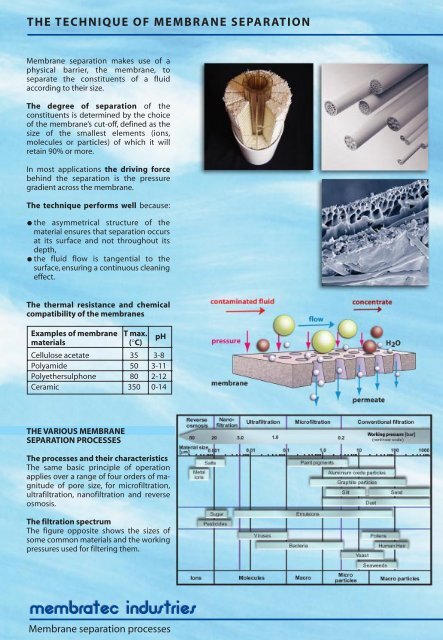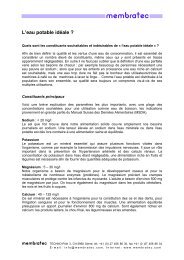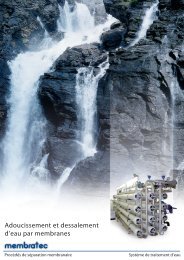Fluid treatment in the aluminium industry Membrane ... - Membratec
Fluid treatment in the aluminium industry Membrane ... - Membratec
Fluid treatment in the aluminium industry Membrane ... - Membratec
You also want an ePaper? Increase the reach of your titles
YUMPU automatically turns print PDFs into web optimized ePapers that Google loves.
THE TECHNIQUE OF MEMBRANE SEPARATION<br />
<strong>Membrane</strong> separation makes use of a<br />
physical barrier, <strong>the</strong> membrane, to<br />
separate <strong>the</strong> constituents of a fluid<br />
accord<strong>in</strong>g to <strong>the</strong>ir size.<br />
The degree of separation of <strong>the</strong><br />
constituents is determ<strong>in</strong>ed by <strong>the</strong> choice<br />
of <strong>the</strong> membrane’s cut-off, def<strong>in</strong>ed as <strong>the</strong><br />
size of <strong>the</strong> smallest elements (ions,<br />
molecules or particles) of which it will<br />
reta<strong>in</strong> 90% or more.<br />
In most applications <strong>the</strong> driv<strong>in</strong>g force<br />
beh<strong>in</strong>d <strong>the</strong> separation is <strong>the</strong> pressure<br />
gradient across <strong>the</strong> membrane.<br />
The technique performs well because:<br />
<strong>the</strong> asymmetrical structure of <strong>the</strong><br />
material ensures that separation occurs<br />
at its surface and not throughout its<br />
depth,<br />
<strong>the</strong> fluid flow is tangential to <strong>the</strong><br />
surface, ensur<strong>in</strong>g a cont<strong>in</strong>uous clean<strong>in</strong>g<br />
effect.<br />
The <strong>the</strong>rmal resistance and chemical<br />
compatibility of <strong>the</strong> membranes<br />
Examples of membrane<br />
materials<br />
Cellulose acetate<br />
Polyamide<br />
Polye<strong>the</strong>rsulphone<br />
Ceramic<br />
T max.<br />
(°C)<br />
35<br />
50<br />
80<br />
350<br />
pH<br />
3-8<br />
3-11<br />
2-12<br />
0-14<br />
THE VARIOUS MEMBRANE<br />
SEPARATION PROCESSES<br />
The processes and <strong>the</strong>ir characteristics<br />
The same basic pr<strong>in</strong>ciple of operation<br />
applies over a range of four orders of magnitude<br />
of pore size, for microfiltration,<br />
ultrafiltration, nanofiltration and reverse<br />
osmosis.<br />
The filtration spectrum<br />
The figure opposite shows <strong>the</strong> sizes of<br />
some common materials and <strong>the</strong> work<strong>in</strong>g<br />
pressures used for filter<strong>in</strong>g <strong>the</strong>m.<br />
<strong>Membrane</strong> separation processes






